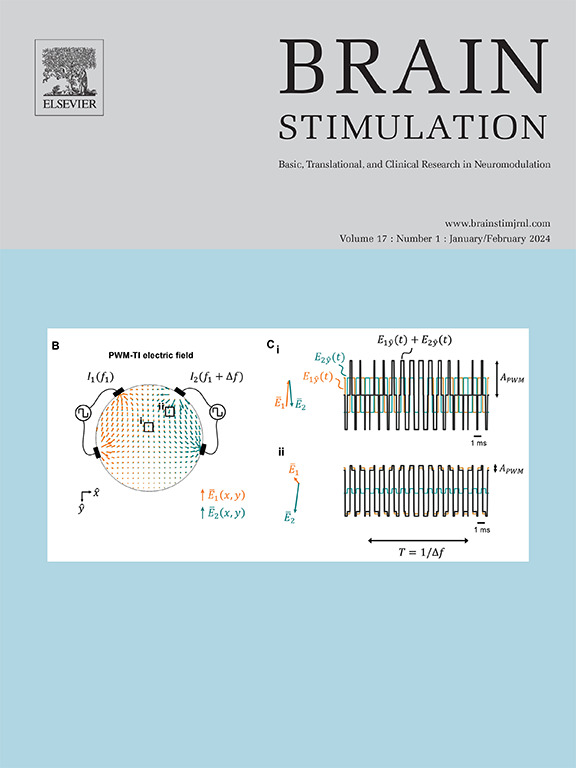Analyses of biomarkers for tremor using local field potentials recorded from deep brain stimulation electrodes in the thalamus
IF 8.4
1区 医学
Q1 CLINICAL NEUROLOGY
引用次数: 0
Abstract
Background
Deep brain stimulation (DBS) of the ventral intermediate nucleus (VIM) of the thalamus (TH) is an effective therapy for suppressing tremor. One of the critical challenges to optimizing VIM-DBS therapy is the lack of robust neural biomarkers that correlate well with tremor.
Objective
To quantify biomarkers for tremor using intraoperative TH local field potential (LFP) recorded from DBS electrodes. Further, we used computational modeling to understand the biophysical basis of the recorded LFP signal.
Methods
We simultaneously recorded intraoperative TH LFP and tremor from the hand dorsum (32 participants) and during DBS at different frequencies (16 participants). Then, we simulated the effects of DBS and spatial distribution of tremor cells on calculated LFPs in a TH model.
Results
There was a moderate correlation between tremor and LFP spectral power in the theta and alpha bands (r = 0.445 and 0.389, respectively). There was a strong correlation between tremor and peak coherence between LFP and tremor signal (r = 0.559). Postural tremor was decoded from the LFP signal with an area under the curve of ∼0.7. High frequency DBS reduced spectral power in the theta and alpha bands and tremor could be decoded from the LFP spectral power in the presence of DBS (0.429 goodness of fit R2). The theta power in the simulated LFP signal varied substantially with the specific location of the bipolar contact pair of the DBS electrode used for the LFP recordings as well as the spatial distribution of tremor cells.
Conclusions
Theta power alone was not sufficient for prediction of tremor control. Simulations indicated that the number and distribution of tremor cells surrounding the DBS lead may explain the lack of a strong correlation between tremor and theta power.
利用丘脑深部脑刺激电极记录的局部场电位分析震颤的生物标志物
背景丘脑腹侧中间核(VIM)深部脑刺激(DBS)是一种有效的抑制震颤的方法。优化VIM-DBS治疗的关键挑战之一是缺乏与震颤密切相关的强大神经生物标志物。目的利用DBS电极记录的术中TH局部场电位(LFP),量化震颤的生物标志物。此外,我们使用计算模型来了解记录的LFP信号的生物物理基础。方法同时记录术中32例患者的TH - LFP和手背震颤,以及DBS时16例患者不同频率的震颤。然后,我们在TH模型中模拟了DBS和震颤细胞的空间分布对计算lfp的影响。结果震颤与theta和alpha波段LFP频谱功率有中等相关性(r分别为0.445和0.389)。LFP与震颤信号的峰值相干性与震颤有较强的相关性(r = 0.559)。从LFP信号中解码体位性震颤,曲线下面积为~ 0.7。在DBS存在的情况下,高频DBS降低了theta和alpha波段的频谱功率,从LFP频谱功率可以解码震颤(拟合优度R2为0.429)。模拟LFP信号中的θ波功率随着LFP记录所使用的DBS电极双极接触对的特定位置以及震颤细胞的空间分布而有很大的变化。结论单纯theta功率不足以预测震颤控制。模拟表明,围绕DBS导联的震颤细胞的数量和分布可能解释了震颤和θ波功率之间缺乏强相关性。
本文章由计算机程序翻译,如有差异,请以英文原文为准。
求助全文
约1分钟内获得全文
求助全文
来源期刊

Brain Stimulation
医学-临床神经学
CiteScore
13.10
自引率
9.10%
发文量
256
审稿时长
72 days
期刊介绍:
Brain Stimulation publishes on the entire field of brain stimulation, including noninvasive and invasive techniques and technologies that alter brain function through the use of electrical, magnetic, radiowave, or focally targeted pharmacologic stimulation.
Brain Stimulation aims to be the premier journal for publication of original research in the field of neuromodulation. The journal includes: a) Original articles; b) Short Communications; c) Invited and original reviews; d) Technology and methodological perspectives (reviews of new devices, description of new methods, etc.); and e) Letters to the Editor. Special issues of the journal will be considered based on scientific merit.
 求助内容:
求助内容: 应助结果提醒方式:
应助结果提醒方式:


